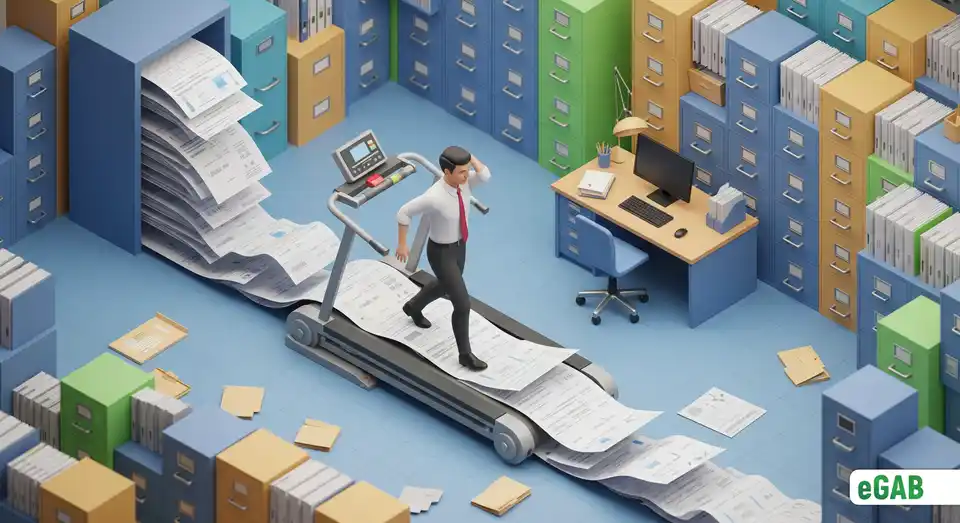How Much Time Are Your Employees Wasting on Paperwork? (A Productivity Analysis)

 Author:
Artem Grigoriev
Author:
Artem Grigoriev
- Why Is Searching for Paper Documents a Major Productivity Killer?
- What Is the Financial Impact of Misfiled and Lost Files?
- How Does Routine Filing and Storage Drain Daily Efficiency?
- What Is the Cumulative Cost of Wasted Employee Hours?
- How eGAB Reclaims Wasted Hours by Automating Paperwork
- Summary: The Hidden Tax of Paperwork and Your Path to Reclaiming Productivity
What if one of the biggest drains on your budget wasn't an official line item? What if it's the silent, compounding hours your team spends just hunting for a piece of paper? We love to blame meetings or digital distractions for lost time. But often, the real culprit is the simple filing cabinet.
The hard truth is, the
time employees waste on paperwork
is a massive hidden cost. Industry analysis shows that inefficient
document management challenges
are a huge problem, slashing overall productivity by a staggering
21%
. This isn't just a minor frustration-it's a daily hunt for information that becomes a major financial drain. It hits your bottom line directly and hurts
employee morale
.
Let's break down the true cost of using paper. We’ll look at everything from the hours lost searching for files to the shocking financial impact of misfiled documents . And most importantly, we’ll show you just how much you can gain from a digital transformation .
📘 This post is part of our comprehensive guide to "The Problems with Paper Documents: A Complete Guide". Explore it to find answers to all your questions ;)
Why Is Searching for Paper Documents a Major Productivity Killer?
Have you ever really stopped to think about where your team's day goes? We tend to point fingers at long meetings or social media, but one of the biggest hidden productivity killers is something you walk past every day: the filing cabinet. It’s hard to believe, but most professionals spend a shocking
1.8
to
2
hours
every single day
just looking for the paper documents they need. That’s up to
25%
of their entire workday wasted. It really makes you ask:
how much time do employees waste on paperwork?
The
time wasted on paperwork statistics
are truly eye-opening.
When you zoom out, the numbers get even more alarming. Research from the
International Data Corporation (IDC)
shows this lost time quickly snowballs, adding up to
8.8 hours per week
for each employee. That’s like losing an entire workday, every single week, to a task that adds zero value. On average, it takes a frustrating
18 minutes
just to hunt down one document, a problem that often requires a dedicated guide for organizing your filing system. This huge
productivity loss from searching for documents
is a textbook example of
how paperwork affects employee productivity
, grinding daily operations to a crawl. For teams in departments like legal, finance, or HR-where paper archives can become a legal time bomb due to data retention rules-this constant searching can devour nearly
50%
of their total work time. And let's be honest, it's rarely about finding
any
document-it's about finding the
right version
. That mistake kicks off a whole new time-wasting cycle of double-checking and verifying information, creating a major slowdown for the entire business.
The financial hit is just as serious. The lost productivity from searching for a single misfiled document costs an estimated
$120
. But the damage doesn't stop there, because that search almost always pulls other people away from their own work. Think about it: that "quick"
5-minute
question you ask a colleague easily turns into
10-15
minutes of lost focus for them, too. You both have to stop what you're doing to find the answer, and then you both struggle to get back into your respective workflows.
Takeaway: This isn't just lost time; it's a hidden tax on your payroll. Every minute your employees spend digging through files is a minute they aren't innovating, helping customers, or driving revenue. Want to see how deep the problem is? Just listen for how often you hear, "Has anyone seen the file for...?" The answer will tell you everything you need to know.

What Is the Financial Impact of Misfiled and Lost Files?
Hunting for a document is a serious time-waster. But what happens when that document isn't just misplaced, but gone for good? This is where the financial impact really hits home. The financial impact of lost documents and the cost of misfiled documents can drain your company's resources, turning a simple administrative slip-up into a major financial headache. This brings us to a critical question: what are the financial risks of lost or misfiled files?
Let's look at the hard numbers, which multiple industry analyses back up. The direct labor cost to track down a single misfiled document is already between
$120
and
$125
-which is painful enough. But the situation gets much worse when a document completely vanishes. A shocking
7.5%
of all paper documents are lost forever, which is why every business needs a disaster-proof document strategy. Because of this,
83%
of employees have had to recreate a missing document from scratch. This creates a massive productivity black hole and introduces critical data security risks, highlighting the dangers of poor
information governance
(having a weak or nonexistent system for managing company data). This is a major theme in industry analysis, as shown in the
2023 State of the Intelligent Information Management Industry Report by AIIM
.
So,
how do you calculate the cost of mismanaging documents?
You have to look far beyond the obvious expenses. The cost to simply reproduce a single lost document is about
$220
. But what about the full administrative cost to recover and replace it, which covers all the time spent searching, verifying information, and getting approvals? That number can skyrocket to between
$350
and
$700
. To put that in perspective, a
$700
recovery cost at a
$25/hr
rate represents up to
28
hours of a skilled employee's time. That's nearly a full work week pulled away from revenue-generating tasks just to clean up a mess that could have been prevented.
Beyond these direct costs lies an even bigger threat: opportunity cost -the value of the other work your team could have been doing. A single lost file can delay entire projects, make you blow past critical deadlines, and damage the trust you've worked so hard to build with your clients. These ripple effects have huge financial consequences, as recreating files pulls your best people away from the work that actually moves your business forward, when they should be focused on innovation and strategy.
Why It Matters: A lost document is never just a piece of paper. It's a direct risk to your project timelines, your client relationships, and your bottom line. The real cost isn't just what it takes to remake the file; it’s all the lost momentum and opportunities your business gives up along the way.

How Does Routine Filing and Storage Drain Daily Efficiency?
It's easy to spot the big productivity hits when a critical file goes missing. But what about the slow, steady drain from routine, everyday paperwork? Let's be honest, all the manual tasks of filing, storing, and managing documents act like a low-grade fever for your business, quietly draining energy and efficiency every single day. These are the hidden costs of paper-based systems -the ones that often go unnoticed but add up fast. This constant drain comes from repetitive, low-value work that holds your team back.
Let's look at the numbers for a moment: filing a single document costs an estimated
$20
in manual labor. In an office that runs on paper, that expense multiplies at a frightening rate. And then there's the physical space itself. In many offices, filing cabinets devour as much as
60%
of your valuable real estate, which is a major contributor to the real estate cost of document storage and creates a huge
overhead cost
-an ongoing expense that doesn't directly help you create your product or service. A single four-drawer cabinet can cost you over
$2,000
a year to maintain when you factor in the price per square foot of your office. An excellent
IDC infographic sponsored by Iron Mountain
does a great job breaking down these hidden real estate and maintenance expenses.
Why are manual workflows inefficient?
Your daily workflows get completely bogged down by these manual processes. Understanding
how paperwork affects workflow
is the first step to improving your
administrative efficiency
. A data entry clerk in a paper-based system might process around
350
documents a day. That's a high-volume, monotonous workload and the perfect recipe for human error, rework, and delays. On top of that, the average employee makes
10,000
photocopies each year-another repetitive task that eats away at daily productivity. Meanwhile, manually routing a document for approval is the ultimate bottleneck in business automation and one of the biggest reasons for process delays. That file sitting on a manager's desk waiting for a signature? It can easily stall an entire project for days. These
manual document processing inefficiencies
are a constant drag on your business. Even off-site storage, which can seem like a good idea, just adds another layer of inefficiency with retrieval requests and transportation delays.
Quick Insight: Think of your paper-based workflows as a road filled with tiny speed bumps. Hitting one or two doesn't feel like a big deal. But when your employees have to drive over hundreds of them every single day, their momentum grinds to a halt. The good news? You can pave over those bumps. By using workflow automation-letting technology handle those repetitive tasks automatically-you can unlock a surprising surge in daily productivity.

What Is the Cumulative Cost of Wasted Employee Hours?
When you add up all the time your team spends searching for, recreating, filing, and managing paper, the cumulative cost is staggering. The cost of paperwork for business isn't just about toner and paperclips. We're not talking about a minor inefficiency; this is a major strategic liability -a core weakness that hits your bottom line and hurts your ability to compete in today's fast-paced digital world. What is the true cost of using paper documents? It's the sum of all those lost hours and missed opportunities.
Here's the bottom line: across all tasks,
document management challenges
cause a shocking
21.3%
loss in overall employee productivity. That isn't just an abstract number; according to a landmark IDC analysis, it translates into a direct, tangible cost to your business. We're talking
$19,732
per information worker (an employee whose job is primarily handling data), every single year. For a company with
100
employees, that annual productivity loss can easily top
$1.9 million
. To put that another way, it’s like paying the full salaries of
21
employees who produce nothing of value for an entire year. This issue ties directly into broader business trends identified in
IDC's Future of Work research practice
, which stresses that technology should be enhancing what people can do, not holding them back.
This constant administrative churn-the endless cycle of repetitive, low-value paperwork-does more than just burn through money. It actively prevents your employees from focusing on the high-value, strategic goals that drive growth, like innovation, proactive customer service, and competitive analysis. The negative relationship between employee productivity and paperwork can also lead to poor employee morale and burnout . In a collaborative workplace, this inefficiency creates a painful domino effect. One person waiting for a document creates a bottleneck that can stall progress for an entire team, and the wasted time gets multiplied across your whole organization.
Ultimately, this mountain of wasted time from paperwork is more than just an operational problem. It's a direct threat to your organization's potential. So, how can automation solve paperwork problems? It starts by shifting your mindset. Paperwork acts as a handbrake on your ability to move fast, adapt, and grow in a competitive market. The solution lies in a smart digital transformation initiative, often centered around moving to a paperless office environment. Implementing a modern document management system (DMS) lets you automate repetitive tasks, secure your information, and give instant access to anyone who needs it. This leads directly to the core business question: what are the benefits of going paperless for a business? The answer is a significant return on investment (ROI) driven by reclaimed productivity and reduced operational costs.
Next Step: Here’s an eye-opening exercise: calculate your own "wasted wage" cost. Just multiply the number of your employees by
$19,732. The number you get is a conservative estimate of how much paper-based inefficiency is costing your company every year. Seeing that figure is often the most powerful catalyst to kickstart a much-needed digital transformation (the process of adopting modern digital technology to replace outdated manual systems).

How eGAB Reclaims Wasted Hours by Automating Paperwork
How much of your team's day is wasted on a frustrating scavenger hunt for information? Paper-based workflows are a known productivity killer, turning simple jobs into time-sucking chores. eGAB reclaims those wasted hours by automating paperwork . We turn your most difficult paper processes- verification, retrieval, and sharing -into instant digital actions .
The biggest impact you'll see is on document verification . What used to take a string of phone calls, emails, and manual checks now takes just a single scan of a QR code . You can cut confirmation times from days or weeks down to just a few seconds. That isn't just an improvement; it's a total reinvention of how you work.
By giving you a centralized, searchable, and secure digital repository , eGAB also ends the time your employees waste digging through filing cabinets and archive boxes. No more hunting for misfiled folders or lost documents. Moving away from manual administrative tasks frees up your team to focus on the strategic, high-value work that drives your business agility and boosts productivity.
Why It Matters: Wasted time isn't just inefficient-it hits your bottom line and drains employee morale. When you automate the tedious parts of the job, you empower your team to do the creative, innovative work you hired them to do.

Summary: The Hidden Tax of Paperwork and Your Path to Reclaiming Productivity
So, what's the bottom line when you put it all together? The reality is that paperwork isn't just a minor headache. It's a massive, hidden tax on your company's time, money, and potential.
It all starts with a shocking fact: your employees are likely losing up to a quarter of their workday-that’s nearly two hours every single day-just
searching for the documents
they need. This isn't just wasted time; it's a direct blow to your bottom line. It costs your business around
$120
every time a single document gets misfiled. And it costs a staggering
$700
to completely recreate one that's lost for good. The
financial impact of lost documents
isn't a theory. It's a constant drain on resources that pulls your team away from valuable, revenue-generating work.
Beyond those dramatic moments of loss, there's the slow, daily grind of
manual document processing inefficiencies
. Just think about the
$20
cost to file one document. Consider the thousands you spend annually on space-hogging filing cabinets. And what about the endless bottlenecks created when a file just sits on a desk, waiting for a signature?
These seemingly small friction points add up to a major strategic problem. The cumulative effect is a shocking
21.3%
loss in overall employee productivity, which translates to an annual cost of nearly
$20,000
per employee
. For a mid-sized company, this liability easily spirals into a multi-million-dollar issue.
Ultimately, this mountain of wasted hours from paperwork is a handbrake on your company's ability to grow and adapt. The solution lies in a strategic digital transformation . By moving towards a paperless office and implementing a modern Document Management System (DMS) , you do more than just get rid of paper. You reclaim those lost hours. You automate the repetitive tasks that destroy morale. You also empower your team to focus on the high-value, innovative work that truly drives your business forward.
The question is no longer if paperwork is costing you. It’s how quickly you can act to stop the bleeding.
➡️ Next up: Wasted productivity is a clear sign of systemic issues. Learn how paper-based processes are the ultimate bottleneck for business automation.

Beyond the Shredder: 5 Critical Data Security Risks of Paper Documents
Why Your Paper-Based Office is Failing Your Remote Team
The Environmental Footprint of a Single Paper Document: A 2025 Report
A Practical Guide to Organizing Your Paper Document Archive
Are Your Paper Archives a Legal Time Bomb? Understanding GDPR and Data Retention
